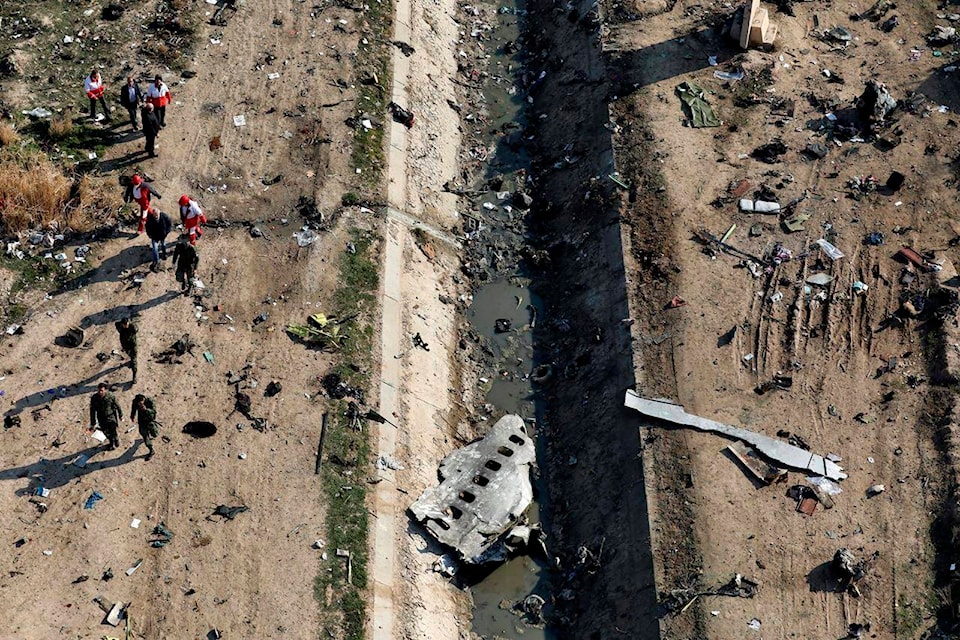Iran’s civil aviation authority is blaming “human error” as the reason why a passenger jet was shot down by the Iranian military in January 2020, outlining its findings in a report the Canadian federal government rejected Wednesday as insufficient.
Iran’s Revolutionary Guard fired two missiles at Ukraine International Airlines Flight 752 shortly after it took off from Tehran on Jan. 8 last year, when “the aircraft was misidentified as a hostile target by an air defence unit,” says the agency’s final report into the crash.
Foreign Affairs Minister Marc Garneau and Transport Minister Omar Alghabra largely dismissed the 145-page document, which was posted to the website of Iran’s Civil Aviation Organization.
“The report makes no attempt to answer critical questions about what truly happened. It appears incomplete and has no hard facts or evidence,” the ministers said in a statement.
“We remain deeply concerned about the lack of convincing information and evidence, despite the publication of this investigation report.”
The government is continuing to call for a “comprehensive and transparent” investigation conducted according to international standards.
Under international civil aviation law, the Iranian government led the investigation.
The report, which Canada’s Transportation Safety Board says it will comment on at a news conference scheduled for Thursday, echoes what the Iranian military said last year: human error caused the tragedy — an explanation found wanting by multiple countries that lost citizens.
Iran initially denied responsibility for the crash, but three days later said the Kyiv-bound Boeing 737-800 was shot down by accident after being mistaken for a missile amid heightened tensions with the United States. The admission came after video footage on social media appeared to show at least one missile striking the jet.
The disaster unfolded after Iran launched missiles into Iraq at two American military bases in retaliation for the U.S. having killed top Iranian general Qassem Soleimani near the Baghdad airport by order of then-U.S. president Donald Trump.
All 176 people on board the jetliner were killed, including 55 Canadian citizens, 30 permanent residents and dozens of others bound for Canada.
“Their families deserve answers to important questions, including on the series of events that led to these missiles being launched in the first place, and why the airspace was allowed to remain open during a period of heightened hostilities,” Garneau and Alghabra said in their joint statement.
Britain, Ukraine Afghanistan and Sweden also lost citizens when the plane was destroyed, and the countries formed a coalition with Canada to deal with Iran.
A series of mistakes led to the fatal missile launch, the Iranian investigation team found.
An incorrect read on the plane’s flight direction due to “human error” caused an operator to perceive the aircraft as flying northeast toward Tehran at a low altitude, rather than flying west away from the main airport, which it was.
The operator tried to alert the command centre to the apparent threat, “but the message was never relayed,” the report states.
“Without receiving a go-ahead or response from the command centre, he came to identify the target as a hostile one and fired missile (sic) at the aircraft against the procedure planned.”
The first warhead exploded near the aircraft, hurling more than 2,500 pieces of shrapnel toward it at nearly 6,500 km/h — more than five times the speed of sound — damaging the plane and aircraft systems but leaving its structural integrity intact, according to the report.
“(T)he three cockpit crew members were all still alive. They appeared to have sustained no physical injuries.”
The second missile “likely” did affect the aircraft, but the plane plummeted to the ground regardless, crashing near the airport and exploding on impact six minutes after takeoff and three minutes after the first missile detonated, the report said.
Prime Minister Justin Trudeau has urged Iran to provide justice and transparency to the victims and their families.
In December, Iran pledged to pay $150,000 to each family that lost someone on the plane, but the offer was rejected by Ralph Goodale, the former Liberal public safety minister who was named Canada’s special adviser on the response to the crash.
He said Iran doesn’t have the right to offer compensation to victims’ families unilaterally and that the final amount will be subject to negotiations between Iran and Canada and the four other countries whose citizens were killed on the plane.
Trudeau has promised Canada will offer a pathway to permanent residency for some family members, while those already here could apply to stay if needed. He also designated Jan. 8 as the National Day of Remembrance for Victims of Air Disasters.
The federal government also said scholarships would be set up in memory of the victims.
This report by The Canadian Press was first published March 17, 2021.
